Installing Oracle Solaris Express 11 under Hyper-V
Some time ago I tried to virtualize under Hyper-V different versions of Sun Solaris x86 from the oldest to the newest. Unfortunately, then full success was not achieved. Solaris was installed successfully and even started under Hyper-V, but the emulated network adapter did not work in the guest OS. It is clear that with such flaws it was impossible to use Solaris for anything serious.
In connection with the purchase of Sun by Oracle, the OS was renamed Oracle Solaris. For testing by community forces, the freely available Solaris Express 11 was released. There were hopes that a new broom from Oracle would change the development of OS-embedded drivers for the better. So I decided to test how Oracle Solaris Express 11 will feel under Hyper-V.
To those who are in a hurry, I can say that the result turned out to be quite satisfactory. Despite the fact that Solaris is not officially supported by Microsoft under Hyper-V and the integration components for it are missing, it works stably and with acceptable performance.
')
Well, for those who are curious about the details of the installation, screenshots of amazing beauty and test results, please follow under the cat.
So proceed to install. Download the Solaris Express 11 distribution , create a new virtual machine, connect the distribution as a bootable DVD, remove the synthetic network adapter and add the Legacy Network adapter.

We start the virtual machine and give answers to all standard questions like partitioning the hard disk, setting the host name, assigning a root password. To obtain the IP address was selected DHCP. Static assignment of IP addresses to the network interface also works fine. It was tested after installing the OS.
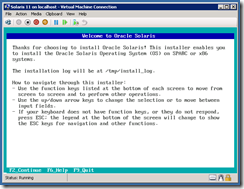



After that, the installation will begin, which will take about 15-20 minutes. Then the OS will reboot and you will see the grub prompt. There is no need to configure anything, so click “Enter” and boldly continue to watch the OS boot.

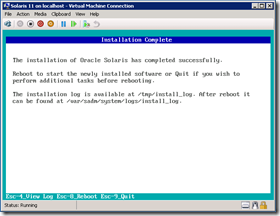
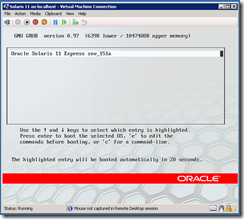
After loading, we enter and see that the dnet0 network interface works fine in emulation mode but allows you to work with the network at a speed of no more than 100 Mbps. In idle mode, the load on the CPU is less than 1%.
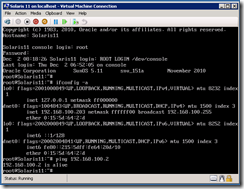
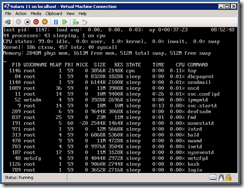
I also tested switching between static IP addressing and DHCP. Then I performed network load testing by transferring about ten gigabytes of data via FTP. In the mode of data transmission through the network, the load on the guest processor rises to 3%.
Since the launch of the OS has worked in this mode for four days. Any errors and deviations in the behavior of the OS is not noticed. There are no error logs either. I think it can be assumed that it will continue to work stably.
As you can see, working with Unix under Hyper-V is not at all difficult, even if you do not have Hyper-V integration components.
At the same time, it is worth noting that the guest OS can be given not one processor, but two or four. As a result of the transition to a dual-processor configuration, the system begins to slow down. Not much, but still noticeable even with the naked eye. The addition of four processors leads to a deceleration of the guest OS so strong that it becomes uncomfortable to use it.
This allows us to conclude that at the moment using Solaris Express 11 under Hyper-V to create high-performance multiprocessor systems will not succeed. However, even a single processor provided by the guest OS is enough to provide it with quite good performance. It turns out that while the system can be used for training and testing. Another task with which this installation will be able to cope is consolidation under Windows Server 2008 R2 or free Hyper-V Server 2008 R2 inherited infrastructure services based on older versions of Solaris. This will enable SC DPM-based backup to virtual machines, SC OpsMgr monitoring, deployment and management using SC VMM.
In connection with the purchase of Sun by Oracle, the OS was renamed Oracle Solaris. For testing by community forces, the freely available Solaris Express 11 was released. There were hopes that a new broom from Oracle would change the development of OS-embedded drivers for the better. So I decided to test how Oracle Solaris Express 11 will feel under Hyper-V.
To those who are in a hurry, I can say that the result turned out to be quite satisfactory. Despite the fact that Solaris is not officially supported by Microsoft under Hyper-V and the integration components for it are missing, it works stably and with acceptable performance.
')
Well, for those who are curious about the details of the installation, screenshots of amazing beauty and test results, please follow under the cat.
So proceed to install. Download the Solaris Express 11 distribution , create a new virtual machine, connect the distribution as a bootable DVD, remove the synthetic network adapter and add the Legacy Network adapter.

We start the virtual machine and give answers to all standard questions like partitioning the hard disk, setting the host name, assigning a root password. To obtain the IP address was selected DHCP. Static assignment of IP addresses to the network interface also works fine. It was tested after installing the OS.




After that, the installation will begin, which will take about 15-20 minutes. Then the OS will reboot and you will see the grub prompt. There is no need to configure anything, so click “Enter” and boldly continue to watch the OS boot.



After loading, we enter and see that the dnet0 network interface works fine in emulation mode but allows you to work with the network at a speed of no more than 100 Mbps. In idle mode, the load on the CPU is less than 1%.


I also tested switching between static IP addressing and DHCP. Then I performed network load testing by transferring about ten gigabytes of data via FTP. In the mode of data transmission through the network, the load on the guest processor rises to 3%.
Since the launch of the OS has worked in this mode for four days. Any errors and deviations in the behavior of the OS is not noticed. There are no error logs either. I think it can be assumed that it will continue to work stably.
As you can see, working with Unix under Hyper-V is not at all difficult, even if you do not have Hyper-V integration components.
At the same time, it is worth noting that the guest OS can be given not one processor, but two or four. As a result of the transition to a dual-processor configuration, the system begins to slow down. Not much, but still noticeable even with the naked eye. The addition of four processors leads to a deceleration of the guest OS so strong that it becomes uncomfortable to use it.
This allows us to conclude that at the moment using Solaris Express 11 under Hyper-V to create high-performance multiprocessor systems will not succeed. However, even a single processor provided by the guest OS is enough to provide it with quite good performance. It turns out that while the system can be used for training and testing. Another task with which this installation will be able to cope is consolidation under Windows Server 2008 R2 or free Hyper-V Server 2008 R2 inherited infrastructure services based on older versions of Solaris. This will enable SC DPM-based backup to virtual machines, SC OpsMgr monitoring, deployment and management using SC VMM.
Source: https://habr.com/ru/post/109592/
All Articles